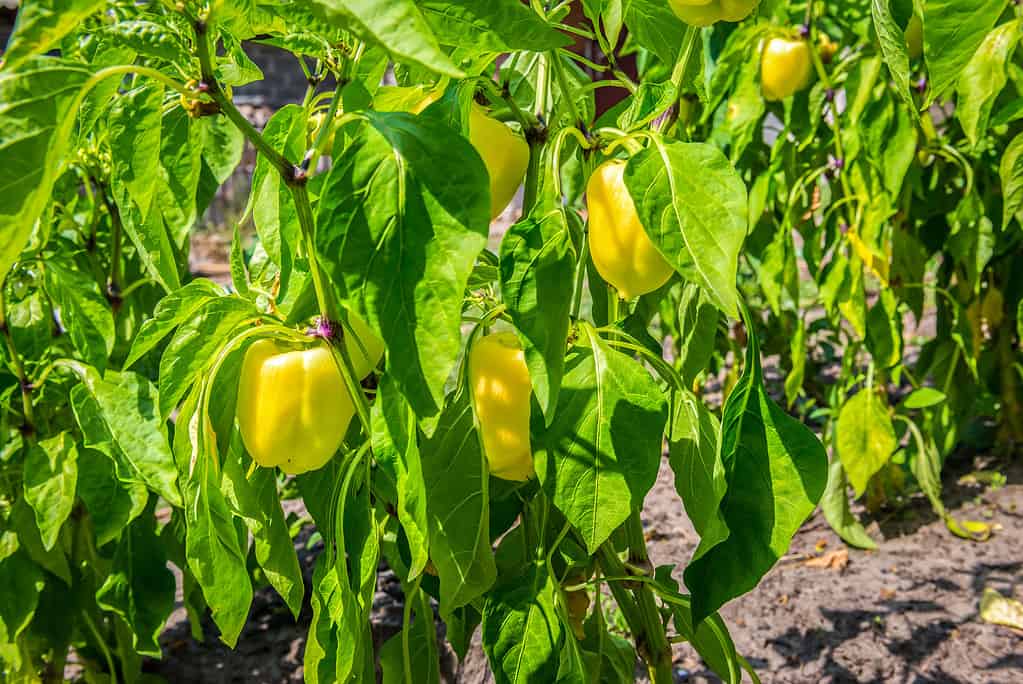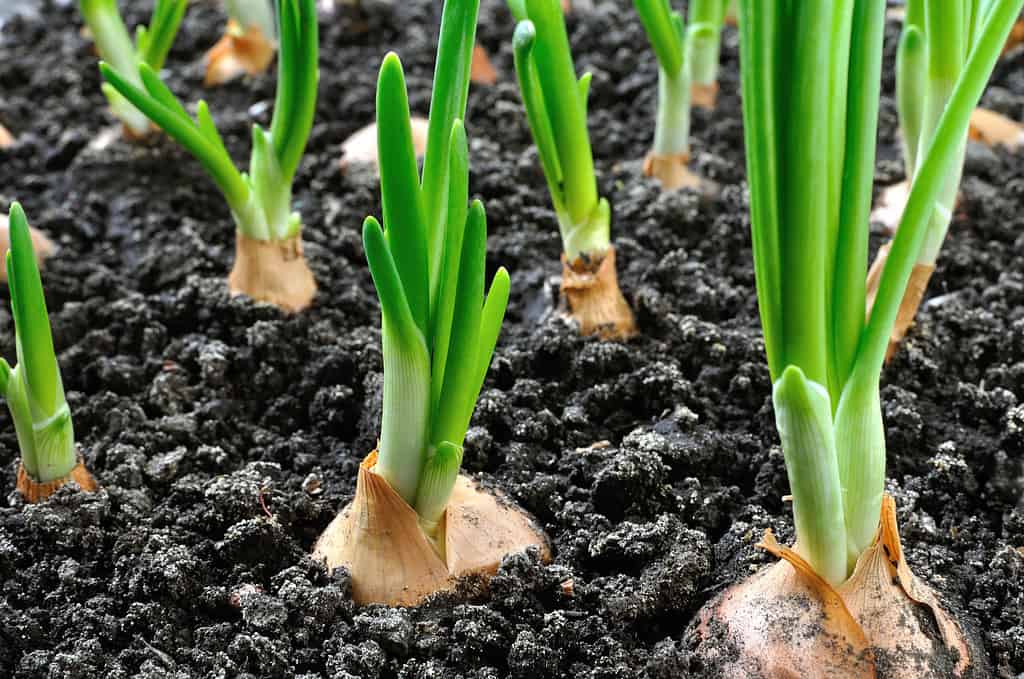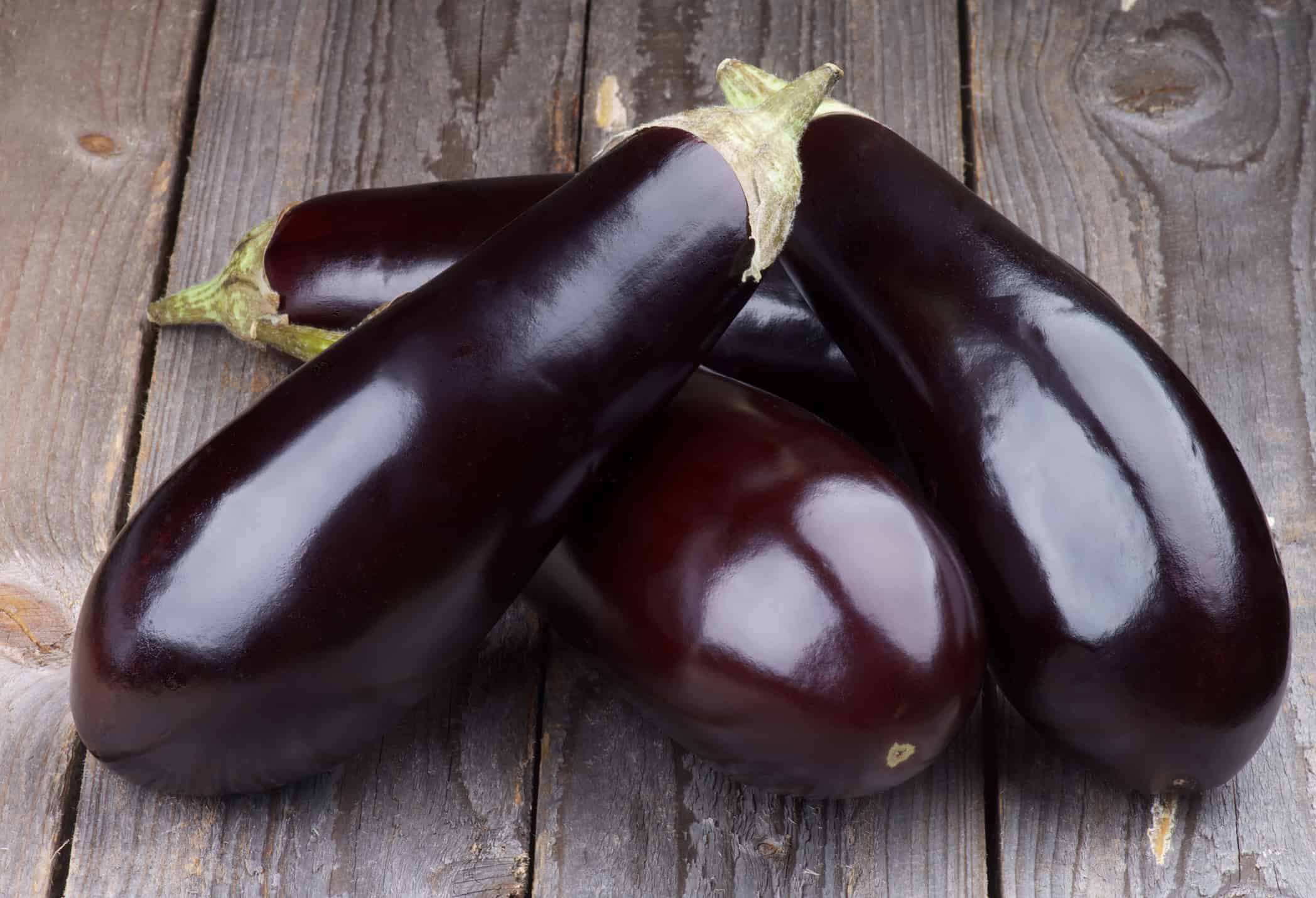Choosing the right companion plants can boost eggplant growth and fend off pesky pests, while the wrong ones may spell disaster for your precious purple harvest.
The concept of companion planting is simple: certain plants naturally support each other, promoting healthy growth and protection against common threats. By harnessing these natural relationships, you can reduce the need for chemical pesticides and foster a more sustainable garden environment.
But not all plants play nice with eggplants. Some may compete for resources, stunt their growth, or attract harmful insects that spell trouble. It’s crucial to avoid these unfavorable partnerships to ensure your eggplants reach their full potential. In this article, we’ll explore the best and worst companions for eggplants, helping you create a harmonious and thriving garden.
Plants to Avoid Planting With Eggplant
1. Corn
Corn is not a good companion plant for eggplant due to several reasons. First, corn is a heavy feeder that requires a lot of nutrients from the soil, which can lead to competition with eggplant for essential resources. As a result, both crops may suffer from stunted growth and reduced yields.
Just as well, corn is a tall and dense plant that can cast a shadow over the eggplant. This blocks the much-needed sunlight from reaching the eggplant, hindering its photosynthesis process and overall development.
Also, corn’s strong root system can outcompete the shallow roots of eggplant, depriving the eggplant of water and nutrients, making it more susceptible to stress and diseases.
Lastly, corn attracts pests like corn borers, which can harm eggplant as well. Sharing the same planting space can facilitate the spread of pests and diseases between the two plants, leading to more significant losses.
2. Melons
To start, melon and eggplant have different water and nutrient needs. Melons are heavy water consumers, requiring consistently moist soil, while eggplants prefer well-drained soil and less frequent watering. Planting them together can lead to overwatering or underwatering one of the crops, affecting their growth and health.
Also, melon plants tend to spread and take up a lot of space as they grow, which can overshadow eggplant plants. This deprives the eggplants of sufficient sunlight, crucial for their proper development and fruit production.
Just as well, melons are susceptible to certain pests and diseases that can also affect eggplant plants. Planting them nearby increases the risk of these issues spreading between the two crops, potentially leading to reduced yields and lower-quality produce.
Furthermore, both melons and eggplants belong to the same plant family, Solanaceae, which makes them more prone to sharing common pests and diseases. Growing them together can create a more attractive environment for these problems to thrive.
3. Fennel
Fennel releases natural compounds through its roots and leaves that can inhibit the growth of nearby plants, including eggplant. This process, known as allelopathy, may negatively affect the development and overall health of the eggplant.
Also, both fennel and eggplant have distinct space requirements. Fennel is a tall and bushy plant that can cast shade over the eggplant, reducing the amount of sunlight it receives. Since eggplants thrive in full sun, this shading can hinder their growth and productivity.
Furthermore, fennel attracts beneficial insects like ladybugs and spiders, which feed on common eggplant pests such as aphids. However, these beneficial insects might also prey on eggplant pollen and young seedlings, leading to unintended damage to the eggplant crop.
Fennel’s strong aroma can also attract certain pests that might also affect eggplants, further increasing the risk of infestation. To ensure the best results for both plants, it is recommended to keep fennel and eggplant separate in the garden
4. Tomato
Both tomato and eggplant belong to the same plant family, Solanaceae. Planting them together increases the risk of sharing common pests and diseases that affect this plant family. This proximity can create a more favorable environment for pests and diseases to spread, potentially harming both crops.
Secondly, both tomato and eggplant have similar nutrient requirements, which can lead to competition for essential elements in the soil. This competition may result in stunted growth and reduced yields for both plants.
Just as well, tomato plants tend to grow vigorously and can overshadow the eggplant, limiting the amount of sunlight the eggplant receives. Since eggplants thrive in full sun, this shading can negatively impact their growth and fruit production.
Moreover, some varieties of tomatoes are more susceptible to certain pests, like the Colorado potato beetle, which can also infest eggplants. Planting them together can attract these pests and make controlling their populations more challenging.

Tomatoes are safe to grow in the same garden as eggplant; just try to keep them separated.
©Digihelion/Shutterstock.com
The Best Companion Plants for Eggplant
1. Beets
Beets are an excellent companion plant for eggplant for several reasons. Firstly, beets have shallow root systems, while eggplants have deeper roots. This difference allows both plants to efficiently use soil nutrients without competing for resources, promoting better overall growth and health.
Beets act as a natural repellent for some pests that commonly target eggplants. The strong aroma and compounds released by beets can help deter pests like aphids and spider mites, reducing the risk of infestations on the eggplant.
Beets can act as a beneficial trap crop for eggplants, too. Some pests, such as flea beetles, are more attracted to beets than eggplants. By interplanting beets among the eggplants, these pests are drawn away from the main crop, minimizing damage to the eggplant leaves.
Just as well, beets are fast-growing plants, and their dense foliage can provide some shading for the soil around the eggplants. This shading helps retain moisture and reduces weed growth, creating a more favorable environment for the eggplants to thrive.
Beets and eggplants have different peak harvesting times, allowing for efficient space utilization in the garden. As the beets are harvested, it opens up space for the eggplants to spread and grow further, maximizing the productivity of the garden area.
Lastly, the diversity of crops in the garden attracts a more extensive range of beneficial insects. By planting beets alongside eggplants, it encourages a diverse insect population that can help control pests and promotes a healthier garden ecosystem.
2. Peppers
Both peppers and eggplants belong to the Solanaceae family, sharing similar growing requirements and tolerances. This compatibility allows them to thrive when planted together, as they have comparable nutrient needs and environmental preferences.
Peppers can act as natural deterrents for certain pests that commonly afflict eggplants. Their pungent aroma and compounds can help repel pests like aphids, spider mites, and flea beetles, reducing the risk of infestations on the eggplant crop.
Just as well, the structure of pepper plants complements that of eggplants. While peppers grow upward, they have narrower canopies compared to the bushy foliage of eggplants. This difference in growth habits ensures that both crops receive ample sunlight, without one overshadowing the other, fostering optimal growth and fruit production.
Interplanting peppers and eggplants enhance biodiversity in the garden, too. The presence of different plant species attracts a wider range of beneficial insects, which can aid in natural pest control and pollination, ultimately benefiting both crops.
Lastly, rotating pepper and eggplant crops can help prevent the buildup of soil-borne diseases and pests specific to these plants. By varying the crops in the same location from season to season, the risk of pest and disease infestations is significantly reduced.

Bell peppers do particularly well when planted with eggplants.
©iStock.com/Kateryna Kolesnyk
3. Spinach
Spinach is an excellent companion plant for eggplant due to several beneficial attributes. Firstly, spinach has a shallow root system, which complements the deeper roots of eggplants. This allows both plants to efficiently utilize soil nutrients without competing for resources, promoting healthier growth for both crops.
Just as well, spinach acts as a natural mulch when grown alongside eggplants. The dense foliage of spinach shades the soil, helping to retain moisture and suppress weed growth. This not only conserves water but also reduces the competition for resources between the two plants, leading to improved yields for both crops.
Spinach also protects eggplants by acting as a living barrier against certain pests. The strong aroma and compounds released by spinach can deter pests like aphids and spider mites, reducing the risk of infestations on eggplants.
Just as well, interplanting spinach and eggplant enhances the diversity of the garden ecosystem, attracting a wider range of beneficial insects. These insects, such as ladybugs and lacewings, can help control pest populations naturally, contributing to a more balanced and sustainable garden environment.
Also, the contrasting growth habit of spinach and eggplant complements each other. Spinach grows low to the ground, while eggplants have taller structures. This ensures efficient use of vertical garden space, allowing both crops to thrive side by side.
4. Potatoes
Potatoes and eggplants have different root structures, which means they do not compete for nutrients in the soil. These tasty vegetables develop their tubers underground, while eggplants have deeper roots, allowing both crops to thrive without hindering each other’s growth.
Potatoes can act as a natural barrier against certain pests that target eggplants. The pungent compounds released by potatoes can repel pests like Colorado potato beetles, which are known to damage eggplant foliage. This protective effect benefits both crops, reducing the risk of pest infestations.
Also, interplanting potatoes and eggplants improves space utilization in the garden. As potatoes grow tall and leafy, they can provide partial shading for the eggplant plants, which appreciate some relief from intense sunlight. This shading helps maintain soil moisture and minimizes weed growth, creating a conducive environment for both crops.
Rotating potatoes and eggplants in the same area from season to season can also help reduce the risk of soil-borne diseases and pests. By varying the crops, the buildup of specific plant-related issues can be avoided, leading to healthier plants and improved yields.
Lastly, the diversity of crops in the garden attracts a wider range of beneficial insects, which contribute to natural pest control and pollination. Both potatoes and eggplants can benefit from this increased biodiversity, promoting overall garden health.
5. Onion
Onions emit a strong scent that repels many common insect pests, such as aphids and thrips, which are known to attack eggplants. By interplanting onions and eggplants, the pungent aroma of onions acts as a natural deterrent, reducing the risk of pest infestations and promoting healthier growth for both crops.
The growth habit of onions complements that of eggplants. Onions have a relatively low and compact structure, while eggplants grow taller with bushier foliage. This difference in growth allows for efficient use of garden space, preventing overshadowing and ensuring that both crops receive adequate sunlight for optimal development.
Just as well, onions are beneficial in deterring larger pests, such as rabbits and deer, from feeding on eggplants. Their presence can help protect the vulnerable eggplant crop, preventing potential damage caused by these animals.
Onions are also known to accumulate sulfur, a natural fungicide. This sulfur content in the soil can help reduce the risk of fungal diseases that might affect both onions and eggplants, contributing to a healthier garden environment.
Onions can also assist in weed suppression around eggplants. Their dense foliage helps shade the soil, limiting weed growth and reducing competition for nutrients and water.

Onions are one of the top companion plants for eggplant due to their fungus and pest prevention capabilities.
©yuris/Shutterstock.com
6. Lettuce
Lettuce has a shallow root system, which complements the deeper roots of eggplants. This difference allows both plants to efficiently utilize soil nutrients without competing for resources, fostering healthier growth for both crops.
Lettuce also acts as a natural living mulch when planted alongside eggplants. The dense foliage of lettuce shades the soil, helping to retain moisture and suppress weed growth. This conserves water and reduces the need for frequent watering, while also minimizing competition for nutrients between the two crops.
The contrasting growth habit of lettuce and eggplant also proves beneficial. Lettuce grows low to the ground, while eggplants have taller structures. This ensures efficient space utilization in the garden, with the lettuce serving as a living ground cover beneath the eggplant plants.
Interplanting lettuce and eggplant can enhance pest management in the garden. While lettuce is relatively less susceptible to certain pests that target eggplants, the presence of lettuce can draw these pests away from the eggplant crop, providing a form of natural pest control.
Lastly, lettuce is a fast-growing plant, making it an excellent “catch crop” for gardeners. As lettuce matures relatively quickly, it can be harvested before it interferes with the growth of the eggplants. This allows gardeners to maximize the productivity of their garden space and enjoy successive harvests.
7. Radishes
Radishes have a shallow root system that complements the deeper roots of eggplants. This allows both crops to efficiently use soil nutrients without competing for resources, leading to improved growth and overall health for both plants.
Radishes also act as a natural pest deterrent when grown alongside eggplants. The strong aroma and compounds released by radishes can help repel certain insect pests, such as aphids and flea beetles, which are known to attack eggplants. This natural defense mechanism reduces the risk of pest infestations on the eggplant crop, promoting a thriving garden.
Radishes can also help improve soil conditions for eggplants. As radishes grow, they can break up compacted soil with their root growth, improving soil aeration and drainage. This benefits the eggplants, as they prefer well-draining soil for optimal growth.
Radishes can also serve as a “trap crop” for some pests that commonly target eggplants. Certain insects are more attracted to radishes than eggplants. By interplanting radishes among the eggplants, these pests are drawn away from the main crop, minimizing damage to the eggplant leaves.
Lastly, the quick growth cycle of radishes makes them an ideal “companion catch crop” for eggplant gardeners. Radishes mature relatively fast, allowing for early harvests without interfering with the growth of the eggplants. This efficient use of garden space enables gardeners to maximize their yields.
Thank you for reading! Have some feedback for us? Contact the AZ Animals editorial team.








